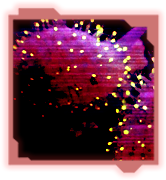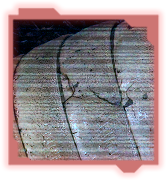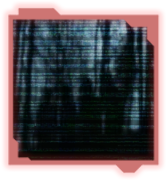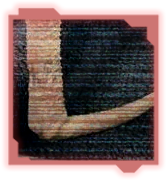
As agents of the multiverse, we will run into many threats and dangers in our travels, but the enemy we are here to fight is the Corruption. It is uncertain where the Corruption originates, or how intelligent it is. It seems to act as a hive mind, drawing in and absorbing those souls it infects until it spreads across entire worlds. In dimensions where it has infected space faring races, it has consumed entire galaxies. Infections can be prevented, or destroyed, but we have not yet found a way to reverse the infection once it has completely taken over a host, though we hold out hope.
Be aware. Be vigilant. Come back safe.
OOC Corruption Questions
(Click to Expand)

❔
Are there still plants/animals/air on dead/Corrupted worlds?
❗ Yes! Though these worlds have been changed, they still exist almost as ghosts of themselves. Infected plants and animals become shades, much like people, and like other Unawakened Shades, they mostly go through the motions of their old lives until they are disturbed or directed by an outside force. Bees still pollinate, trees grow beneath a sepia sun, the shadows of fish flicker through ashen streams, all in complete silence.
That being said, it would probably be a bad idea to eat an apple from a Corrupted tree (if it even would taste like anything). Water is generally safe enough, as are things like canned food, but any living food sources should be avoided until purified. This can occur naturally over weeks in areas where the active sources of Corruption have been driven out, or within a few hours if
Vital has been applied.
❔
Can the Corruption affect deities or beings like The Endless?
❗ The Corruption is a sort of anti-reality-- a hole in what is. If a particular entity is strongly tied to their world, they would likely suffer to the extent their world/followers would suffer, but really that extent is up to you. Beings like The Endless would have a lot more immunity, as they don't really exist in any one place over another, but if the Corruption somehow got into their realms or enough worlds succumbed to it, they might notice effects.
❔
Can non-agents find Artifacts?
❗ Someone without a Key Gauntlet may stumble across a Corrupted Artifact accidentally, but they would have to be incredibly powerful in order to hunt them down purposefully without that sort of outside assistance, and we would prefer you talk with staff first if you would like your character to have that capability.
❔
What happens if my character uses an Artifact?
❗ The Artifacts are kind of like The One Ring. They'll slowly gain more influence over a user over time, depending on the strength of their will and the power of the Artifact. An Artifact will always act in its own best interest, and with the goals of opening Rifts and further spreading the Corruption.
❔
Are the Artifacts always magical in nature?
❗ Nope! They can be high tech, or even just mostly mundane instead. Sometimes an Artifact's only goal is just being in the right place at the right time, like a conveniently placed knife on a table behind a politician during a heated argument. The magical ones tend to be the most dangerous and crafty, however.


No one is entirely sure how Artifacts come to be. Some theorize that they must have an existing connection to the arcane or eldritch in order for Corruption to take root and give them power, while others point out that some Artifacts have little to no abilities at all. Either way, Artifacts give off an energy signature that Walker blood is drawn to, and therefore can be tracked via Key Gauntlets.
These Artifacts exist with the sole purpose of causing enough destruction and destabilization within a world that a rift in time and space is torn open through which polyps can slip through and grow into Behemoths. If a Behemoth is already present and growing somewhere, they exist to create food sources for it, which can range from unstable magics to nuclear war. Behemoths aren’t picky.
Some Artifacts are semi-sentient, and can actively influence people that touch or venture near to them. As such, it is incredibly important that operatives are careful when handling them. In an emergency, a bit of raw silk can be used to temporarily handle and contain the less powerful ones, but
Artifact Containment Gear is recommended when possible.
Artifacts and their powers and influences can only be completely nullified when placed into a Walker’s Vault. The main vault is located in a hidden location in Sanctuary, but the Omphalos has a smaller working Vault for temporary holds as well.


Rifts can occur quickly in places where enough destructive energy is released, or more slowly over time in places of great emotional turmoil. They can also be created artificially by those with the power to do so– Gates and Doors are a type of benign Rift.
Unlike the Rifts caused by the Corruption, Gates are made with surgical precision, and are healed over again when they are closed. There are naturally occurring Rifts as well, like those that draw unlucky individuals from their own worlds to Sanctuary or other Nexus points, but those are exceedingly rare, and tend to heal up on their own within a few hours. Corrupted Rifts are ragged wounds in time and space, which can grow and become infected if not treated, allowing Behemoth polyps through to take root and spread.
Omphalos operatives can carry tools called temporal needles that can be fired at Rifts to allow them to knit back together and drive back any infection. These tools can be carried and used by anyone, but there are plenty of other ways to heal a Rift which may speed up the process depending on the skill set of the given team. Many magic users have a natural affinity for it.
All Rifts should always be approached with caution, but Corrupted Rifts especially. Reality tends to break down the closer one gets to the Rift, and the bigger the Rift, the worse the effects. One never knows what they might encounter, and it takes precious time to heal a Rift, time which may be taken advantage of by enemy parties. One should always wear
protective gear while working with a Rift, or they risk madness or mutation, even from secondary contact with objects or animals who have been recently warped.


Polyps come in by the thousands through the rifts. They are incredibly small, each starting out no bigger than a bit of dandelion fluff, and they’re just as light, using the wind to carry them large distances. They then land and begin to burrow, seeking out dark, dank, hidden places where they can grow and grow and grow. If a polyp manages to take root, it will eventually become a Behemoth.
Thankfully most worlds are not hospitable environments for these tiny horror fluffs. When worlds are healthy, they have many natural defenses that kill off the majority of invading polyps. Artifacts begin to appear with the very purpose of destabilizing those defenses, tearing open new rifts, and creating food sources for these polyps to grow.
And if even one polyp manages to grow into a full sized Behemoth, things can go very bad, very, very quickly.


Behemoths grow from polyps, drifting in through rifts. Most take several months to grow to the size where they are a problem, feasting on the energies the rift produces and on the energetic detritus of the world they’ve taken root in. Scavengers will bring Behemoths organic matter and sources of energy for them to absorb into themselves, even such things as batteries or small animals like rats. However, unstable energy sources such as radiation or corrupt magic makes Behemoths grow much faster, so they often seek out polluted areas or war zones to infest.
They often burrow beneath cities or within cave systems while they are small, and then emerge when they are large enough to begin creating Heralds and infecting the local populace. At this point, a Behemoth’s huge, slug-like body is near invulnerable. They are best taken care of when small, because if they are large enough to begin producing Heralds, then they can only be destroyed from the inside.
Luckily, Behemoths are not smart– they leave that to their squid-like defenders– and they will not try very hard to avoid swallowing things like explosives if one can get close enough.
Behemoth nests are rife with Herald eggs, and Scavengers hatch from the very back of the monster. Equally hazardous to magic users, Behemoths often tap into and completely drain the local ley lines, and if not properly shielded, an unwary spellcaster may find their own wells tapped dry too.
Behemoths are immense, usually about 100ft or so from head to tail when they are full grown. They are a sludgy gray and slug-like, and use a host of four powerful, clawed fins to get around and burrow up towards the surface. Thankfully once they are full grown, they are not incredibly mobile, though they can thrash about well enough.
Behemoths that are not full grown will hide themselves within lairs underground, which tend to be putrid in smell and very cold. They can grow very quickly if left unchecked, particularly if there is plenty to eat.


Heralds are born from Behemoths, therefore they are only present in an area if a Behemoth is somewhere nearby. They are swift, flight capable creatures resembling some terrible cross between an emaciated squid and a bramble bush, and tend to grow to about six feet in length.
At the outer limits of a Behemoth’s territory, Heralds tend to travel alone, but they group together more the closer one gets to a Behemoth’s lair. They do not speak themselves, but they are far more intelligent than they may appear, and some are alarmingly good strategists, choosing to communicate their intentions through the packs of Shades they control.
Heralds do not tend to strike themselves, as they are fairly delicate. Their thorny appendages are for corrupting captured individuals in order to make more Shades. They can become incorporeal as a defense mechanism, which can make for problems. However, in order to control the Shades beneath their command, they must be solid, and they must be still enough to concentrate. Many choose to wedge themselves up somewhere in order to hide while doing so, and they can fit into annoyingly small spaces to do it.
Fortunately for everyone but the Heralds, they can also be tracked in the same way as the Shades themselves, as they tend to be a much lower temperature than their surroundings.
Being captured by a Herald is not an immediate death sentence. It takes several hours for most average individuals to succumb to the Corruption, and those who are strong willed or possess abilities that can help them fight off the infection may last even longer. Those who escape may experience exhaustion and apathy for days afterwards, but they will eventually recover.
We do not yet know of any way to reverse Corruption once it has taken hold.



 No one is entirely sure how Artifacts come to be. Some theorize that they must have an existing connection to the arcane or eldritch in order for Corruption to take root and give them power, while others point out that some Artifacts have little to no abilities at all. Either way, Artifacts give off an energy signature that Walker blood is drawn to, and therefore can be tracked via Key Gauntlets.
No one is entirely sure how Artifacts come to be. Some theorize that they must have an existing connection to the arcane or eldritch in order for Corruption to take root and give them power, while others point out that some Artifacts have little to no abilities at all. Either way, Artifacts give off an energy signature that Walker blood is drawn to, and therefore can be tracked via Key Gauntlets.
 Rifts can occur quickly in places where enough destructive energy is released, or more slowly over time in places of great emotional turmoil. They can also be created artificially by those with the power to do so– Gates and Doors are a type of benign Rift.
Rifts can occur quickly in places where enough destructive energy is released, or more slowly over time in places of great emotional turmoil. They can also be created artificially by those with the power to do so– Gates and Doors are a type of benign Rift.
 Polyps come in by the thousands through the rifts. They are incredibly small, each starting out no bigger than a bit of dandelion fluff, and they’re just as light, using the wind to carry them large distances. They then land and begin to burrow, seeking out dark, dank, hidden places where they can grow and grow and grow. If a polyp manages to take root, it will eventually become a Behemoth.
Polyps come in by the thousands through the rifts. They are incredibly small, each starting out no bigger than a bit of dandelion fluff, and they’re just as light, using the wind to carry them large distances. They then land and begin to burrow, seeking out dark, dank, hidden places where they can grow and grow and grow. If a polyp manages to take root, it will eventually become a Behemoth.
 Behemoths grow from polyps, drifting in through rifts. Most take several months to grow to the size where they are a problem, feasting on the energies the rift produces and on the energetic detritus of the world they’ve taken root in. Scavengers will bring Behemoths organic matter and sources of energy for them to absorb into themselves, even such things as batteries or small animals like rats. However, unstable energy sources such as radiation or corrupt magic makes Behemoths grow much faster, so they often seek out polluted areas or war zones to infest.
Behemoths grow from polyps, drifting in through rifts. Most take several months to grow to the size where they are a problem, feasting on the energies the rift produces and on the energetic detritus of the world they’ve taken root in. Scavengers will bring Behemoths organic matter and sources of energy for them to absorb into themselves, even such things as batteries or small animals like rats. However, unstable energy sources such as radiation or corrupt magic makes Behemoths grow much faster, so they often seek out polluted areas or war zones to infest.
 Heralds are born from Behemoths, therefore they are only present in an area if a Behemoth is somewhere nearby. They are swift, flight capable creatures resembling some terrible cross between an emaciated squid and a bramble bush, and tend to grow to about six feet in length.
Heralds are born from Behemoths, therefore they are only present in an area if a Behemoth is somewhere nearby. They are swift, flight capable creatures resembling some terrible cross between an emaciated squid and a bramble bush, and tend to grow to about six feet in length.
 Shades are simultaneously the least dangerous and the most dangerous of the Corrupt. Each of them was once a person, captured and twisted by one of the Heralds. No one knows if the process can be reversed, or what happens to Shades if they are killed. Some theorize that they return after destruction, but many of them are so uniform looking that it’s hard to tell, and no one wants to find out for certain.
Shades are simultaneously the least dangerous and the most dangerous of the Corrupt. Each of them was once a person, captured and twisted by one of the Heralds. No one knows if the process can be reversed, or what happens to Shades if they are killed. Some theorize that they return after destruction, but many of them are so uniform looking that it’s hard to tell, and no one wants to find out for certain.
 Scavengers are more ugly than they are directly dangerous. They are semi-humanoid and about the size of a cat, with elongated, crab-like legs. They scurry across the landscape once a Behemoth has become established, collecting resources from the surrounding areas to bring back to the nest. This makes them a problem for establishing base camps outside of enclaves, as they can climb nearly any surface and will strip any organic material or power source that they can find, magical or mundane.
Scavengers are more ugly than they are directly dangerous. They are semi-humanoid and about the size of a cat, with elongated, crab-like legs. They scurry across the landscape once a Behemoth has become established, collecting resources from the surrounding areas to bring back to the nest. This makes them a problem for establishing base camps outside of enclaves, as they can climb nearly any surface and will strip any organic material or power source that they can find, magical or mundane.






